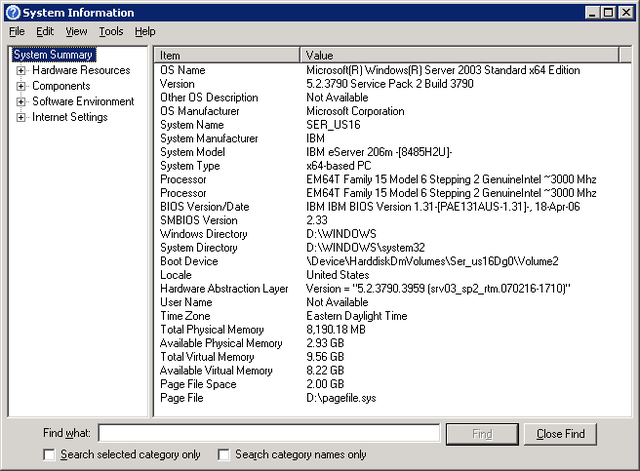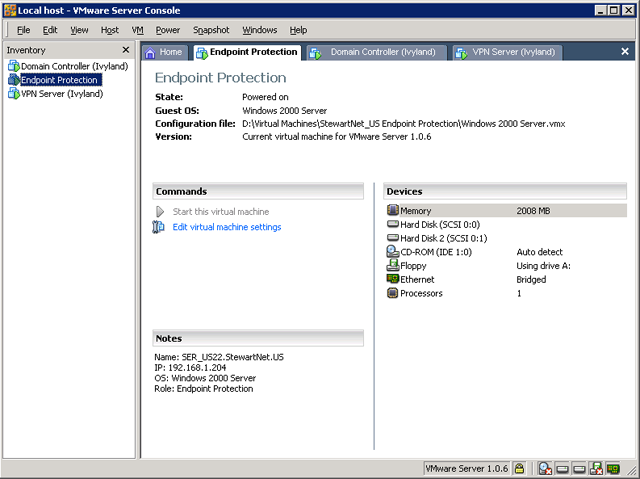How it all works...

On a computer that will act as a host for the VMs we need to install a Virtual Machine Server and here there are two basic choices; those you pay for an those you don't. VMWare has been in the virtualization business as long as anyone and now offers a robust range of Servers and Players (a Player is a piece of software that enables you to run a VM in a similar way that a Media Player runs a media file - even from a USB thumb-drive). VMWare's ‘free' Virtual Machine Server requires installation on top of an operating system (such as Windows Server or Linux) whereas those requiring purchase of a license have an embedded operating system kernel.
Although Microsoft has a free Virtual Server offering, at the time I started experimenting with Virtualization, Microsoft's solution was more recent and had some 64-bit operating system limitations, so I chose VMWare Server.
It is important to realize that the host machine must provide sufficient resources to the VMs to enable them to carry out their tasks efficiently. Figure 3 shows the specification of one of my host machines; as you can see it is running Windows Server 2003 x64, has two CPUs and 8GB of memory.

Figure 3: Specification of a Host Machine.
The 64-bit operating system enabled me to exceed the 4GB of installed memory limitation of 32-bit systems. Note that the total memory being utilized is over 5GB, split between the host and the three VMs.
Once the VM Server application is up and running on the host machine, VMs can be configured. Figure 4 shows the console utilized by VMWare Server. In the left-hand panel is the inventory of VMs and in the right-hand panel the details of the selected VM.
In VMWare Server configuring a VM involves defining the operating environment (Windows, Linux, etc.); the processor (one or more); the amount of memory; the amount of disk space, and; the access required to other peripheral hardware and networks. After configuration an operating system and applications software can be installed. At points within the installation process (for example after the operating system has been installed and updates have been applied) the VM can be copied and archived.
The number of virtual machines which can be installed is dependent upon the resources available in the host. In my server installations, all the servers need to operate continuously but other scenarios are also possible; for example, a PC could be configured to run a VM for gaming and a VM for home management (on-line banking, office applications, etc.). In this scenario it is unlikely that both VMs would be absorbing high resources at the same time (one may not even be running).

Figure 4: VMWare Server Console.
Virtual Machine Servers also have a web-based interface (see Figure 5) so that VMs can be managed from any computer having a web browser without the need to install console software.
- Login to post comments
- 3945 reads

Recent comments
11 years 28 weeks ago
11 years 28 weeks ago
11 years 28 weeks ago
11 years 32 weeks ago
11 years 32 weeks ago
12 years 23 weeks ago
12 years 24 weeks ago
12 years 24 weeks ago
12 years 24 weeks ago
12 years 24 weeks ago
12 years 24 weeks ago
12 years 24 weeks ago
12 years 24 weeks ago
12 years 24 weeks ago
12 years 24 weeks ago
12 years 25 weeks ago
12 years 25 weeks ago
12 years 26 weeks ago
12 years 31 weeks ago
12 years 42 weeks ago
12 years 42 weeks ago
12 years 42 weeks ago
12 years 42 weeks ago
13 years 8 weeks ago
13 years 9 weeks ago
13 years 9 weeks ago
13 years 9 weeks ago
13 years 9 weeks ago
13 years 9 weeks ago
13 years 9 weeks ago
13 years 10 weeks ago
13 years 10 weeks ago